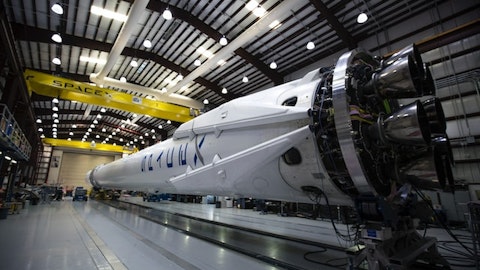Operator: Thank you. One moment for our next question, and that will come from the line of Edward Yruma with Piper Sandler. Your line is open.
Edward Yruma: Hey, good morning. Thanks for taking the question. I guess first one, broader question. I know you guys called out Amazon as being a success story. I wanted to understand if you had any more context behind the remainder of 3P, particularly physical retail like a Dick’s? And then just a clarifying point on the relaunched app, will connected fitness devices have the option for a more a la carte subscription option? Or is that a — is that to remain the All Access membership?
Barry McCarthy: It will remain all access membership. I’m going to ask Liz to comment on Dicks and 3P.
Liz Coddington: Yes, sure. I think the way to think about Dick’s is it still very much a new partnership, a new relationship for us. Recall that we only launched that partnership back in November. So we’ve only got a couple of quarters under our belt with Dicks. And as Barry commented, it’s also about us learning how to be a good wholesale partner to a retail business that is more traditional brick-and-mortar. That’s not where our business has come from. We’ve been mostly web-centric in how we sell and how we deliver to our consumers. So we’re still working through with Dick’s how to be a good partner to them and how to leverage their channel so that we can both be even more successful.
Operator: Thank you. One moment for our next question, that will come from the line of Eric Sheridan with Goldman Sachs. Your line is open.
Eric Sheridan: Thanks so much for taking the questions. First, you talked a lot about the commercial opportunity via the hospitality industry in the letter, and you’ve obviously got the Hilton partnership. Can we talk a little bit about what you think that means in terms of a driver for either the Connected Fitness subscriber funnel and/or bringing additional people into the digital app that, that maybe would utilize your hardware in a more nomadic, sort of, business travel-type sense through partnerships like that? Just want to understand how you think about that as a stimulant to multiple different parts of the business? And then in terms of the guidance you gave one quarter forward, I wanted to understand a little bit of some of the puts and takes in the gross margin guidance that we could better understand how some of the headwinds and tailwinds might evolve, not just in Q4, but as we roll forward into the next fiscal year? Thanks so much.
Barry McCarthy: I don’t have — I’ll talk about the funnel and hospitality and ask Liz to talk about the gross margin puts and calls in the guidance. Really, I don’t have too much to say about hospitality, except that it’s been a fruitful source of consumer demand for us. Enormously productive, historically. I would anticipate that, that will continue on a go-forward basis. And so we like the hospitality business for two reasons. One, profitable in its own right, and two, it’s a good source of future growth for us. Because, as you say, it helps lead the funnel.
Liz Coddington: I’ll take the question about puts and takes for our Q4 margin. So first, just a reminder that our overall gross margin is actually expected to go up quarter-over-quarter to 41% versus the 36% that we had in Q3. And the main driver of that is the shift towards subscription revenue from hardware revenue, because we do expect our hardware sales to be lower in Q4 versus Q3. Our guidance does assume some expected pressure on Connected Fitness gross margins versus is a seasonally weaker quarter for Connected Fitness hardware sales. We’re also expecting some weaker sales and margin outlook for Precor as we continue to revamp that business. And then we do have about 200 basis points of impact to overall gross margin included in our guidance from anticipated onetime items that mainly impacts the Connected Fitness segment.
Operator: Thank you. One moment for our next questions, and that will come from the line of Aneesha Sherman with Bernstein. Your line is open.
Aneesha Sherman: Thank you and nice quarter. My question is about OpEx. So about a year ago, you were talking about or maybe your predecessors were talking about $2 billion in OpEx being the kind of watermark. You’re tracking towards that at this point, and you brought down the cost base quite significantly on an underlying basis. Are you at the tail end of the OpEx improvement and cost cutting stage? Are you looking at this as kind of being the steady state level? Or are you looking for more improvement in the next year or so?
Barry McCarthy: Yes.
Liz Coddington: Yes. So going back to the restructuring plan that we outlined about a year ago, we don’t have a perfect apples-to-apples comparison to that, because we had a number of additional actions that have been taken since we set those targets. But if you actually exclude restructuring, impairments, reserves and settlements, our OpEx is down over $550 million on a trailing 12-month basis as of Q3. And if you can note, that does include the fourth quarter, which still had fairly elevated OpEx mainly in G&A and sales and marketing. On the COGS side, we’ve had significant volume-based dependency when it comes to determining the cost savings there. And while our volume has come down, we’ve continued to make significant progress in optimizing our cost of goods sold over the past year.
Our cost structure now reflects the impact of the restructuring actions that we took to outsource our last mile delivery, exit our own manufacturing and really effectively shift our high fixed cost business model to a much more variable cost model. From a cost structure perspective, we are in much better shape. We do see some further opportunity to optimize cost of goods sold, particularly in the middle mile, and we’re going to be working on that over the coming quarters. With regard to OpEx overall, we have made great progress. We’re not finished, and we’re going to continue to optimize. But the big step function improvement are likely not to happen. It’s going to be more about identifying improvements as we go, things like reducing our professional services spend addressing our tech, which should drive some efficiencies.
There may be some efficiencies and member support. We’re going to continue to look at lowering our real estate costs over time. So those are some of the areas where you’ll continue to see further optimization over the coming quarters.
Barry McCarthy: I would add that…
Aneesha Sherman: Thank you.
Barry McCarthy: I would add that, on a go-forward basis, I think there’s an opportunity for us to take the several categories where there are tens of millions of dollars of savings to be had as opposed to hundreds of millions of dollars of savings. So things related to IT infrastructure and Liz mentioned the middle mile. And this past year, we had a lot of suppliers’ payments by way of settling out inventory commitments and things that are now in the — after this quarter, will be in the completely in the rear-view mirror for us.
Aneesha Sherman: Thank you so much. And if I can ask a quick follow-up for Liz. On your comment about Q4, can you reconcile your comments about seasonality and lower subs versus your guidance of only a modest increase in churn? Is it just about expecting lower gross adds?
Liz Coddington: So seasonally, it’s both, right? So it’s lower gross additions in the quarter expected, because of the lower efficiency to go out and acquire them in the quarter, as well as a seasonal uptick in churn that we see — we’ve seen every year.
Barry McCarthy: No, if we were to relax the constraint we’ve imposed on marketing spending, if we were to relax the free cash flow goal that we’ve set for ourselves, we could absolutely grow faster. Well, we’re not prepared to make that trade-off at the moment until it is kind of what it is.
A – Liz Coddington: The focus is as I was going to say, the focus is on LTV to CAC and making sure that while we’re willing to go lower than we were at in Q3, it has to be relatively efficient.
A – Barry McCarthy: First priority is free cash flow. Second priority is growth.
Operator: Thank you. One moment for our next questions, that will come from the line of Shweta Khajuria with Evercore ISI. Your line is open.
Shweta Khajuria: Thanks a lot for taking my questions. Liz, could you please remind us what promotions you ran in the quarter? And what your expectations are for the upcoming quarter and for maybe upcoming quarters? And then — and in addition to maybe perhaps talking about just the overall demand environment? And then the other follow-up question I have is on free cash flow. So excluding the settlement costs, you are striking distance from breakeven. Could you please help us, just remind us. Outside of growth that you expect coming in for the next year, where — what are the key levers? And how should we be thinking about working capital for the next fiscal year? Thanks a lot.
Liz Coddington: Okay. I think there were a bunch of questions in there. We’ll start with the question on promotions. So what promotions did we have in Q3. So if you recall, we went into the Q3 with a promotion in January related to kind of getting into fitness in the new year. That ended — I don’t have the exact date of the promotion, but that went for part of January. And then we did have a promotion, we did have some referral rewards promotion. We also had a — which is basically, if someone refers someone to Peloton, they get that person gets a discount and then the person who does the referral gets the credit for apparel purchase. And we also did a spring promotion in March that had discounts on hardware purchases and bundles, as well as a promotion on our refurb products, and we also offered a financing promotion, where we would offer free financing — or 0% financing for all of the term lengths for a period of time.
In Q4, we do have some promotional activity planned by Mother’s Day, which actually launches today, our Mother’s Day promo. So that will be starting today. With regard to free cash flow and the question about working capital. So just for Q3 to give you a sense, we did have a cash tailwind from inventory. It was about to the tune of about $100 million net of any supplier settlements that we had in the quarter. We are nearing the tail end of those supplier settlements. We only have about $3 million left that will incur in Q4. For Q4, we also expect inventory to be a bit of a tailwind and source of cash, but it will be materially lower than what we observed in Q3, again, in part because of the fact that we will be selling less hardware in Q3 in Q4 versus Q3.
And then we’re not really providing much perspective on FY ‘24 yet. But as we move into FY ‘24, we expect the tailwind from inventory to continue to moderate over time because we will need to continue to — we will need to produce Connected Fitness hardware inventory for specific SKUs.





